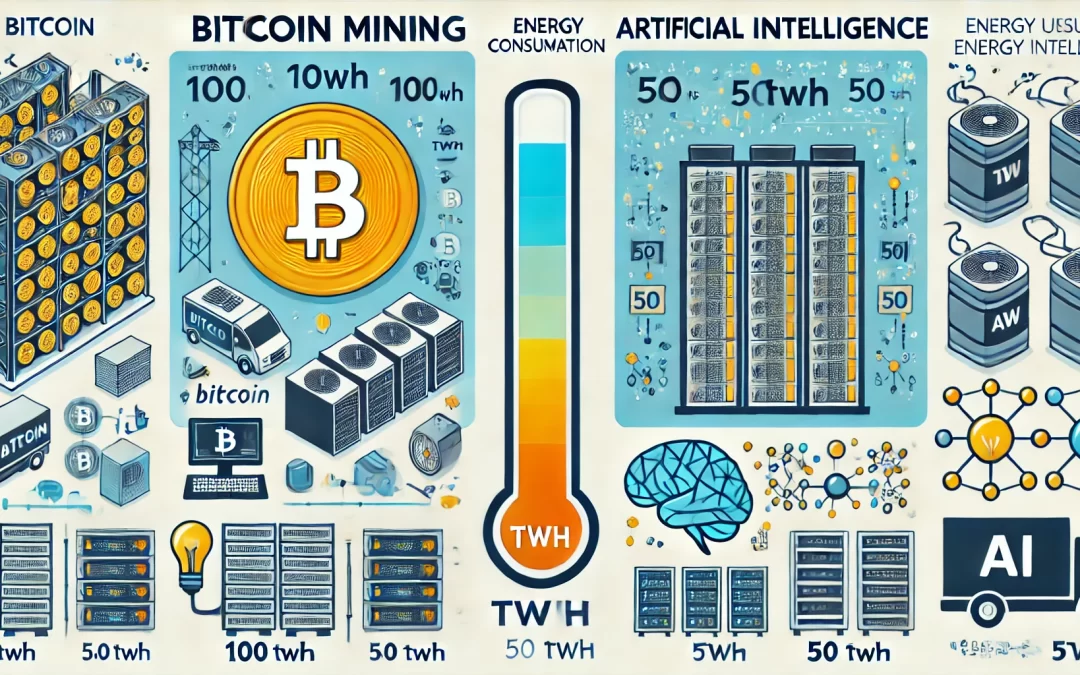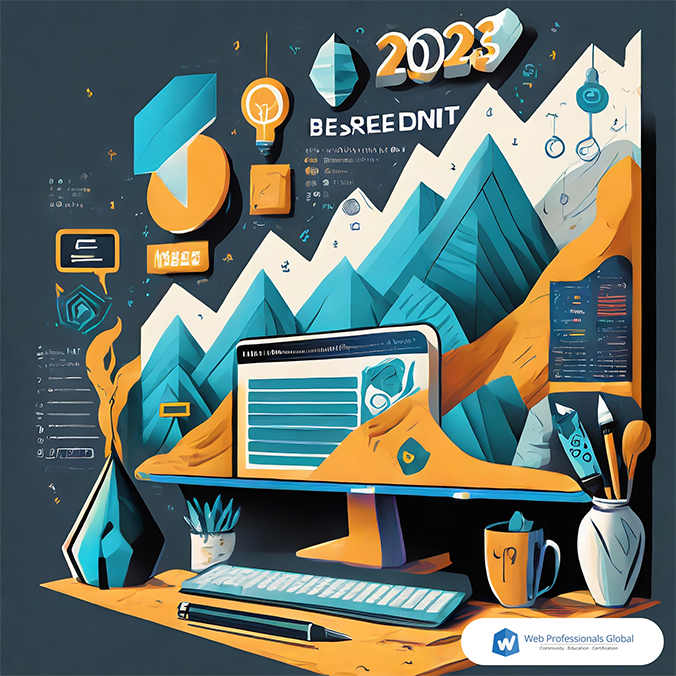
by Mark | Jun 20, 2024 | AI and Machine Learning, Industry News
The image above was created by the ChatGPT Image Generator by searching the phrase “Please create a graphic that shows the difference in energy usage between bitcoin and artificial intelligence.” The image features a Bitcoin mining setup on one side and an AI setup on the other, with a balance scale in the center comparing their energy usage. The background includes tech-related graphics and symbols representing both Bitcoin and AI.
Bitcoin and AI are two of the most transformative forces right now in the world of technology, and we at Web Professionals Global are closely following them and what they mean for the future of our profession. Both bitcoin and AI have significant implications for the future of industries and societies worldwide. However, alongside their promise comes a growing concern surrounding the substantial energy consumption required to power these technologies. Today we are taking a look at the energy dynamics of Bitcoin and AI, comparing their consumption patterns, impacts, and the ongoing debate surrounding their sustainability. Readers may remember a similar article we published in October of last year. In less than a year, energy usage and future usage estimates have increased significantly.
Understanding Bitcoin’s Energy Consumption
Bitcoin operates on a decentralized ledger technology known as blockchain. The process of validating transactions and adding them to the blockchain network, known as mining, is integral to its operation. Bitcoin miners compete to solve complex mathematical puzzles, requiring substantial computational power. This mining process, essential for maintaining the integrity and security of the network, consumes a staggering amount of energy.
The primary driver of Bitcoin’s energy consumption is the Proof of Work (PoW) consensus mechanism. PoW involves miners using specialized hardware to solve cryptographic puzzles, a process that demands immense computational resources. As more miners participate and the network grows, so does the difficulty of these puzzles, leading to increased energy consumption. In fact, the Cambridge Bitcoin Electricity Consumption Index estimates that Bitcoin consumes 112.31 TWh (terawatt-hour) annually. This equals the entire energy consumption of some countries around the world.
Critics argue that Bitcoin’s energy footprint is unsustainable, citing its environmental impact due to reliance on fossil fuels and the potential strain on global energy resources. The decentralized nature of Bitcoin means that anyone with adequate hardware and electricity can participate in mining, creating a competitive race that further escalates energy demands.
The Environmental Debate
The environmental implications of Bitcoin’s energy consumption have sparked intense debate. Proponents argue that Bitcoin incentivizes the development of renewable energy sources, as miners seek cheaper and more sustainable power options to maximize profits. However, detractors point to the current predominance of non-renewable energy sources in Bitcoin mining, particularly in regions with low electricity costs driven by coal and other fossil fuels.
Recent years have seen efforts within the Bitcoin community to promote sustainability. Initiatives such as the Bitcoin Mining Council aim to improve transparency and advocate for the use of renewable energy in mining operations. Additionally, advancements in mining hardware efficiency and the exploration of alternative consensus mechanisms, such as Proof of Stake (PoS), could potentially mitigate Bitcoin’s energy intensity in the future.
AI: Energy Consumption and Computational Needs
Artificial Intelligence, encompassing machine learning (ML) and deep learning (DL), represents another frontier in technological innovation. AI algorithms analyze vast amounts of data to derive insights, powering applications ranging from natural language processing to autonomous vehicles. Like Bitcoin, AI’s advancement relies heavily on computational power, albeit through different mechanisms. The semiconductor analysis firm SemiAnalysis estimates that if Google were to use ChatGPT for every Google search it would require 29.2 terawatt hours (TWh) of annual consumption.
AI’s energy consumption primarily stems from training deep neural networks. Training involves feeding algorithms with enormous datasets and iteratively adjusting model parameters to optimize performance. This iterative process demands significant computational resources, often requiring specialized hardware such as Graphics Processing Units (GPUs) and increasingly, dedicated AI chips.
While training consumes substantial energy, the deployment phase—where AI models make predictions or decisions in real-time—typically requires less power. This distinction highlights the evolving nature of AI energy consumption throughout its lifecycle, from initial development and training to ongoing operational use.
Comparing Energy Intensities
Quantifying the energy consumption of Bitcoin versus AI involves nuanced considerations. Bitcoin’s consumption is continuous and primarily driven by the mining process, which operates 24/7 across global networks. In contrast, AI’s energy use fluctuates based on demand for training and inference tasks, which can vary widely depending on the application and scale of deployment.
Recent studies have attempted to benchmark these technologies’ energy footprints. While direct comparisons can be challenging due to their disparate operational mechanics, some analyses suggest that AI, particularly during intensive training phases, can rival or exceed Bitcoin’s energy intensity over similar periods. However, AI’s energy demands can vary significantly depending on factors such as model complexity, dataset size, and hardware efficiency.
Towards Sustainability and Efficiency
Both Bitcoin and AI face scrutiny regarding their environmental impact and sustainability. In response, stakeholders across industries are exploring avenues to enhance efficiency and reduce energy footprints.
For Bitcoin, innovations in mining hardware and shifts towards renewable energy sources hold promise. Efforts to promote transparency and accountability within the mining community aim to mitigate environmental concerns while ensuring the network’s robustness and security.
Similarly, AI researchers and practitioners are exploring avenues to optimize algorithms and hardware architectures for energy efficiency. Techniques such as model pruning, quantization, and federated learning aim to reduce computational demands without compromising performance. Moreover, advancements in AI hardware, including the development of more energy-efficient processors, contribute to sustainability goals.
Balancing Innovation and Sustainability
As Bitcoin and AI continue to evolve, so too will the discourse surrounding their energy consumption. The imperative to balance technological innovation with environmental sustainability remains critical. Stakeholders must collaborate to foster responsible practices, leverage renewable energy solutions, and advance energy-efficient technologies.
While challenges persist, the potential benefits of Bitcoin and AI are undeniable. From financial inclusivity and decentralized finance (DeFi) enabled by Bitcoin to transformative advancements in healthcare, transportation, and beyond driven by AI, these technologies offer profound opportunities for global progress. How Bitcoin and AI will ultimately unfold remains to be seen, but the impact of both is already clear.
Research estimates that by 2025, the IT industry could use 20% of all electricity produced and emit up to 5.5% of the world’s carbon emissions. That’s more than most countries’ total emissions outside of the U.S., India and China. All of the computers, routers, smart devices and more that make up the internet use an enormous amount of energy. Additionally, as new technologies such as satellite internet expand coverage to areas that traditionally have struggled to get access, the amount of energy that the internet consumes will only continue to grow.
Wrap-Up
We welcome your comments and questions about this topic and the world of the web. Reach out today to find out more about our mission of “Community, Education and Certification.” We are always happy to have new web professionals join our ranks.

by Mark | Apr 30, 2024 | AI and Machine Learning, CSS3, Industry News, Web Accessibility, Web Design Trends, WWW Desktop View
As April is ending, I thought it would be a good time to review articles of interest which I have been reviewing this month (and articles members and colleagues have made me aware of). As readers know, web technologies are always evolving. This is that keeps me interested in all things web (and has for well over three decades).
Accessibility
New software has been developed to enable blind and low vision users to create interactive, accessible charts. The software is called Umwelt and was created by researchers at MIT and University College London. The software is designed for screen reader users.
AI
If you happen to own an iPhone (and it is newer than 5 years old with iOS 17), there are AI features available to you now. These include cinematic video editing (subject can be detected and focus can be changed depending on the action). You can also use the Live Text feature to copy text from images. Yes, this has been around for a while, but has been significantly improved. You can also create stickers from your own photos. Obviously a lot more is coming with IOS 18.
A recent study also revealed a surge in the use of AI to enhance video accessibility. Wistia’s State of Video report is summarized in the linked article. Interestingly, part of the study also found that shorter videos are not necessarily that much more engaging. We encourage you to read the summary and the full report.
CSS
This article on CSS trends for 2024 is most interesting. It is amazing how much continues to evolve with this technology. From new color systems to subgrids to cascade layers, there are many changes happening. Frameworks such as Tailwind CSS, Chakra UI also continue to evolve. Readers are encouraged to check out the above linked article.
Web Design trends
Here are some web design trends emerging in 2024. These include: denser, richer graphics, AI generated designs, micro interactions, kinetic typography and much more continue to evolve.
WordPress
Given that this technology supports roughly 38% of websites, we thought readers might want to know what is new for developers with the release of version 6.5. For those who do not know, the next version (6.6) will drop support for older versions of PHP (7.0 and 7.1). The WordPress Playground continues to evolve and some enhancements are discussed in this article as well.
Those are some of the articles we found interesting in the past month. We are curious what you found interesting as well. Please let us know in the comments.

by Mark | Dec 18, 2023 | Industry News, State of the Web, Web Pro News, Web Professional Trends
As we look back at the digital landscape of 2023, the world of web design and development continues to evolve at a rapid pace, ushering in a new era of innovation and creativity. The team at Web Professionals Global has been fortunate enough to see many of these changes up close. This year, designers and developers have pushed boundaries and redefined user experiences. In this article, we’ll explore the trends that have dominated the web design and development scene in 2023.
As a member, you have access to specific links with all thee articles (providing much more detail). Members should view this linked page for access to all those details. If you are not a member, you will be directed to the join page (members should login first).
Immersive and Interactive Experiences
Web designers are increasingly focusing on creating immersive and interactive experiences to captivate users. With advancements in WebGL and 3D graphics, websites are now offering dynamic and engaging content. From interactive storytelling to product showcases, the web is becoming a more interactive and visually stunning space.
Augmented Reality (AR) Integration
The integration of augmented reality into web design has gained momentum in 2023. AR elements enhance user engagement by overlaying digital information onto the real world. From virtual try-on experiences for e-commerce to interactive educational content, AR is reshaping how users interact with websites.
Dark Mode Dominance
Dark mode has transcended from a trend to a design standard. Offering a sleek and modern aesthetic, dark mode not only reduces eye strain but also conserves device battery life. Major websites and applications are embracing dark mode as a default or optional theme, providing users with a more personalized browsing experience.
Voice User Interface (VUI) Implementation
Voice technology has become more sophisticated, leading to the integration of voice user interfaces in web design. Websites are adopting voice search, commands, and navigation, making it more convenient for users to interact with content hands-free. This trend reflects the growing importance of accessibility and user-friendly interfaces.
Minimalistic and Functional Design
Minimalism continues to be a key design philosophy, with a focus on simplicity and functionality. Clean layouts, ample white space, and intuitive navigation are essential components of modern web design. Striking the right balance between aesthetics and usability, designers are creating seamless and clutter-free digital experiences.
AI-Powered Personalization
Artificial intelligence is playing a pivotal role in web development by enabling personalized user experiences. AI algorithms analyze user behavior and preferences to deliver tailored content, recommendations, and even dynamic website layouts. This level of personalization enhances user engagement and satisfaction.
Blockchain Integration for Security
With an increasing emphasis on cybersecurity, blockchain technology is making its mark in web development. Blockchain provides enhanced security and transparency, making it a valuable addition to websites dealing with sensitive data. This trend is particularly prevalent in e-commerce, finance, and healthcare sectors.
Progressive Web Apps (PWAs)
Progressive Web Apps continue to gain popularity due to their ability to provide a seamless user experience across devices. Combining the best of web and mobile applications, PWAs offer faster load times, offline functionality, and push notifications, enhancing user engagement and retention.
Wrap-Up
In the ever-evolving landscape of web design and development, 2023 has been a year marked by innovation, user-centric experiences, and the integration of advanced technologies. From immersive designs and augmented reality to the widespread adoption of dark mode and AI-driven personalization, these trends collectively shape the digital experiences of users worldwide. At Web Professionals Global,we are excited to continue supporting web professionals around the world and see where the industry goes in 2024. Reach out to us today to find out more about our mission of “Community, Education, Certification.”
If you want more details about any of the above information, please view this linked page (members only – be sure to login first).

by Mark | Dec 7, 2023 | AI and Machine Learning, CSS3, Industry News, JavaScript, Web Accessibility
As 2023 draws to a close, we thought it would be helpful to share some of the articles we have been reading. We have tried to focus on a handful of articles (covering the categories below). As we have noted on previous articles, all links will open in a new browser tab/ window.
Artificial Intelligence
As readers are well aware, the pace of change in AI is hard to fathom. This article summarizes what we should be looking for in late 2023 and early 2024. Perhaps we will look back at this article in mid-2024 and see how the predictions fared.
As you may suspect, the “featured image” accompanying this post was generated by Adobe Firefly.
Accessibility
Web Content Accessibility Guidelines (WCAG) 2.2 were released on October 5. There are many aspects to consider. We found Craig Abbott’s analysis most helpful (this is definitely worth a read).
CSS
If you are even a little curious where CSS might be heading, we encourage you to review Eric Meyer’s article concerning Nuclear Anchored Sidenotes. Of course, you will need a fairly recent version of the Chrome browser with the “experimental web features” option enabled if you want to try out his examples.
JavaScript
JavaScript continues to evolve as well. Here is a good article concerning new features for 2023 and expectations for 2024. Some of the main features discussed including the ability to change an array by copy without mutating the original array. One can also find within an array starting at the end and working backwards.
WordPress
WordCamp US concluded several months ago. However, these presentations provide an overview of many insights provided at this venue. Of course, the annual keynote address by Matt Mullenweg (State of the Word) is scheduled for December 11 (from Spain). We are definitely curious what will be covered in that keynote.
Feedback please!
It has been a few months since we have posted a “desktop view” article. Do you enjoy reading these articles? What other topics would you like to see us cover (to learn more about)? Please let us know in the comments.

by Mark | Nov 29, 2023 | Employment Issues, Industry News
In recent years, we have frequently discussed the rise of remote and hybrid work. As a global organization, we aim to keep members and readers updated on trends happening around the globe that affect the world of the web. Today, we are highlighting a recent development in the United Kingdom that will likely impact how people work not only in the UK but globally as well.
In a November 22 policy announcement, the UK government said that individuals grappling with mobility and mental health challenges may soon find themselves compelled to work from home or risk losing vital benefits under the “Chance to Work Guarantee.” This program, introduced by the Department for Work and Pensions (DWP), is aimed at removing barriers to work for millions of people currently out of work. As part of the plan the DWP will also provide targeted help as part of its £2.5B ($3.1B) Back to Work Plan, including through an expanded program that places people into jobs and provides support to give the best chance of success in a role.
UK Prime Minister Rishi Sunak describes this effort as encouraging people to fulfill “their duty,” as he deemed the current welfare system “unsustainable.” Under the proposed changes, hundreds of thousands of disabled people could face a reduction in benefits of £4,680 (approximately $5,910) annually unless they actively seek remote employment.
In the past few years, the number of people working remotely in the UK has risen significantly. 40% of workers reported working from home in the winter of 2023, compared to 12% in the winter of 2019. Over 20% of 8 million online job ads between April and October 2023 were remote or flexible, up from less than 4% in 2016.
Although it is too early to tell exactly what impact this new policy will have, it is clear that in the coming months and years more people in the UK will need to be equipped with the skills and tools to work remotely. It is also likely that other countries will soon follow the UK and implement their own policies that encourage those on benefits to seek employment from their homes.
Even if you are not disabled, learning how to successfully work on a remote and hybrid basis is extremely valuable. The landscape for work is constantly shifting, and many companies are still utilizing remote work policies that were implemented during the COVID-19 pandemic.
Web Professionals Global offers the Certified Remote Working Professional (CRWP) course and certification to help those transitioning to the world of remote (and hybrid) work. This comprehensive program not only equips you with the skills to become an expert remote worker, but also empowers you to stand out from your peers in the competitive job market. The bonus Interview Preparation and Freelancer Preparation modules are designed to teach you remote and in-person interview skills as well as how to work as a freelancer or independent contractor.
At the end of the course, you will have earned your Remote and Hybrid Working Certification from Web Professionals Global. This globally-recognized certification was created by industry professionals who have worked remotely and on a hybrid basis for many decades, ensuring that your newfound skills receive recognition on a global scale.
For more information on our Certified Remote Working Professional (CRWP) course and certification, or to chat with us about our work, contact us today at membership@webprofessionalsglobal.org.

by Mark | May 8, 2023 | AI and Machine Learning, Industry News, JavaScript
April has been a very busy month at Web Professionals Global. In addition to running the SkillsUSA national web design and development competition, we have been helping more and more states with their statewide web design and development competitions. This year we connected with a significant number. We provided the contest assets (including a work order), a coding environment, judging rubric, and associated videos to help both competitors use the online environment and judges review the work of competitors. This means our monthly update on what is happening in the world of the web is running a bit late.
Here are some of the articles we found interesting. We hope you enjoy learning more about what is happening. As always, we are interested in learning what you are most keen to learn about. Please add a comment and let us know. Here are some categories for the articles we found interesting. As mentioned in previous posts, all links will open in a new browser window/ tab.
- AI and current uses
- Browsers
- JavaScript
AI and current uses
You will note there is a featured image associated with this weblog post. In the past, this was manually generated (using tools such as Adobe Express or similar). The image this month was generate from a test entry describing to Adobe Firefly what was desired. In this example, I entered text asking for a photo of a desktop with an open laptop, an open notebook, pens and pencils on the desk and blooming orchids. The result is what you see. It was generated in under 10 seconds. Yes, AI saves time.
We have also been using AI to generate the client assets for our web competitions. Logo creation, text content, and more are all generated using AI (which saves us considerable time).
As an organization, we support the recently formed Content Authenticity Intiative. We encourage readers to follow the link to learn more about this important initiative.
Browsers
It appears Google is considering updating the venerable padlock depicting SSL sites.They are considering a variant of the tune icon. Read more about it on the Chromium blog. They present a solid rationale for making this change. For example, only 11% of those surveyed really understood what the padlock meant. As they mention, even the FBI mentions the lock icon is no indication of website safety. We are curious as to your thoughts about this change. It appears this will be coming to a Chrome browser near you one of these releases. Let us know your thoughts in the comments.
Speaking of browsers, in case you missed it, April 30 marked the 30th anniversary of the licensing of the web for general use and at no cost. 30 years. WOW. Yes, that was a pun.
One more article you may find of interest – the calm web: a solution to our scary and divisive online world. Karolina Szczur provides many thoughtful insights. She also offers practical ways one can get started. For example, stripping away unnecessary code and removing low quality content.
JavaScript
Although this article is over a year old, it might be worth reviewing (and pointing this out to aspiring web professionals – perhaps those you teach). A web components primer seems a good introduction to the topic. For those of you teaching web technologies – do you discuss web components? Why or why not? What are your thoughts about this article?
Your turn…
That is a quick overview of some articles we found intriguing. We hope you enjoy them as well. What did you find helpful? What would you like to learn more about? Please tell us in the comments.






